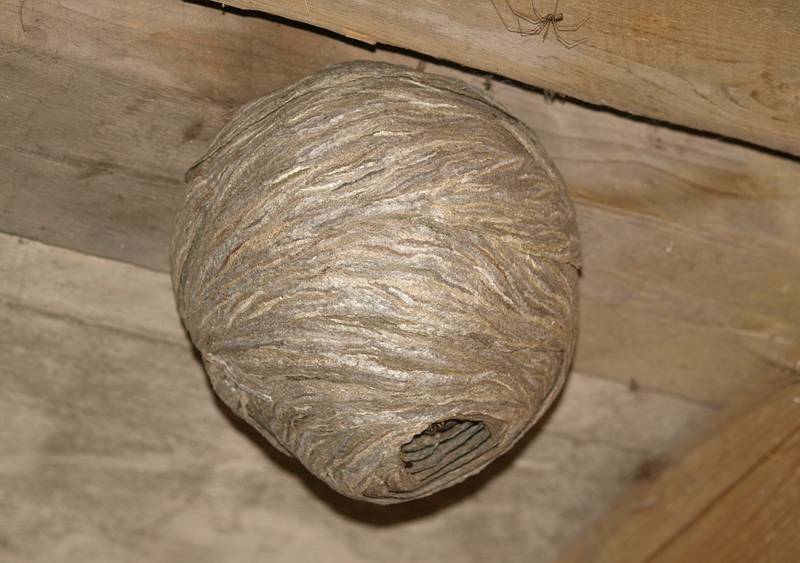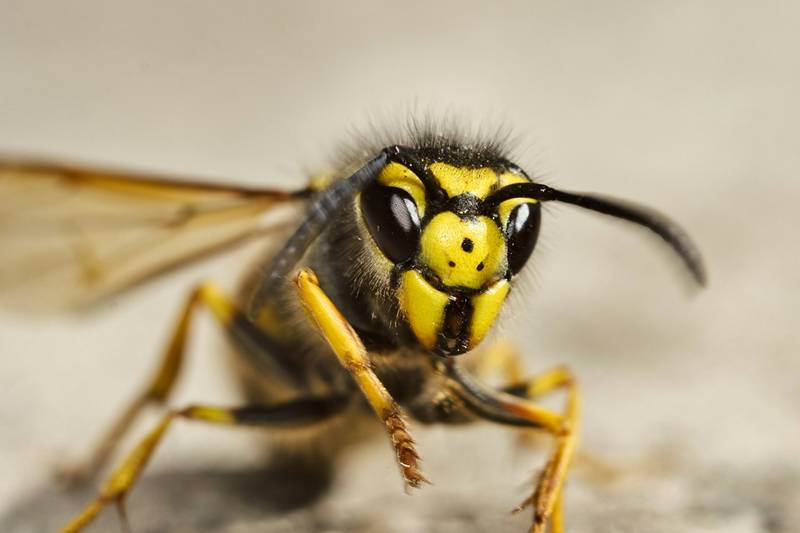
Wasps are a common sight during the warmer months. These insects, while beneficial to the ecosystem, can become a nuisance or even a danger when they build nests in or around homes.
Knowing how to identify different types of wasps, their behaviours, and the best ways to manage their nests is essential for maintaining a safe and comfortable environment.
This blog will cover various types of wasps and how to deal with them…
Just in case you’re unsure, here’s how to distinguish between these similar insects…
Wasps have slender bodies, narrow waists, and smooth skin. They are brightly coloured with yellow and black stripes.
Behaviour-wise, wasps are predatory and often feed on other insects. They can become aggressive, especially in late summer and autumn.
Some of their nests can look quite odd, as they are typically made from chewed wood fibres and saliva. Typically found in sheltered areas, so expect to find nests in places like your shed, though this can vary depending on the type of wasp.

Bees are generally bigger and rounder than wasps, with hairy bodies that help them collect pollen. Honey bees are golden brown, while bumblebees are rounder and covered in dense hair with black and yellow stripes.
As bees are focused on pollination, they are generally non-aggressive. However, honey bees can become defensive if their hive is disturbed.
As for their nests/hives, honey bees build wax combs inside cavities, while bumblebees create smaller nests in the ground.
Larger than common wasps, hornets have a yellow and brown colouration. They are generally less aggressive than wasps unless their nest is threatened.
Their nests are larger and more enclosed than wasp nests, often found in hollow trees or wall cavities.
Common wasps have slender bodies with narrow waists, smooth skin, and bright yellow and black stripes. They have two pairs of wings and long antennae.
These wasps build paper-like nests made from chewed wood fibres mixed with saliva. The nests have a characteristic umbrella shape and are usually found in sheltered areas such as under eaves, in lofts, or in trees and bushes.
Despite their name, yes, they can be found in the UK - and have spread to many other parts of the world…
German wasps look similar to common wasps but can be distinguished by the three black dots on the front of their faces, though since they are known as one of the most aggressive species found in the UK, it’s not recommended to get that close to them!
Their nests are similar to those of common wasps, often found in similar locations. And more reason why you should exercise caution when approaching any wasp nest.

Even though they have their differences, hornets are part of the wasp family, and so European hornets are another common type of wasp found in the UK.
They are larger than common wasps, with some reaching up to 5.5 cm in length. They have a yellow and brown colouration.
Like the European hornets themselves, their nests are larger and more enclosed than wasp nests. The nests are typically found in hollow trees, wall cavities, or high in trees.

Wood wasps, also known as horntails, have a similar body shape to other wasps but are larger and have a long, cylindrical body. Wood wasps are not aggressive and rarely sting humans.
These kinds of wasps do not build communal nests. Instead, the females have a long ovipositor that resembles a stinger but is used for laying eggs in dead or dying wood. The larvae cause some damage to this wood as they develop and grow out of it.
To identify an infestation, look for small holes in wood surfaces, which indicate where the female wood wasp has laid her eggs. And to prevent infestations, keep wood in good condition and treat it with insecticides if necessary.
Generally, you should be looking for nests in sheltered locations such as under internal or exterior roof edges, in lofts, or in trees and bushes.
Wasp nests have a paper-like appearance and can vary in size. Use the information on different types of wasp and nests to further help with this.
Avoid Disturbing: Do not disturb the nest. If the nest is in an awkward or high traffic area and needs removing, it is best to seek advice from a professional pest controller.
Prevention: Seal cracks and holes in your home’s exterior to prevent insects (and even small rodents) from entering. Keep food and garbage tightly sealed to avoid attracting wasps.
Keep an Eye Out: Regularly inspect your property for signs of nests, especially during the spring and summer months.
Avoid Swatting: Swatting at wasps can provoke them. Instead, move away slowly and calmly if you encounter these insects.
Whether having a BBQ or simply sunbathing in your garden or a park, here’s some tips to prevent wasps from bugging you…
⦁ Keep food and drinks covered
⦁ It may be worth placing wasp traps around the perimeter of your seating area to reduce their presence.
⦁ Avoid bright colours and instead opt for muted clothing. Also resist wearing strong, sweet smelling perfumes.
⦁ If a wasp approaches, remain calm and avoid swatting. Move away slowly to avoid provoking an attack.
Though you could try dealing with things yourself using a combination of sting-protective gear (thick clothing, gloves, face mask) and/or by using a wasp-specific insecticide spray on the nest at night when wasps are less active; there are still risks.
You may become overwhelmed if a number of wasps swarm and attack. If the nest is in an awkward place, you could injure yourself or fall from a ladder, etc.
You also may be allergic to stings and just not know it yet!
The safest, quickest and most effective way to handle a wasp nest is to call a professional. Whether it’s a large nest or one in a difficult to reach location, our wasp removal service can take care of the problem.
With an understanding of wasps and their nests, as well as knowing how to differentiate them from bees and hornets, you can effectively manage their presence around your home.
By taking preventive measures, identifying nests early, and calling in professionals when needed, you can ensure a safer and more comfortable environment.
Whatever kind of pest you’ve got a problem with, let our expert local pest controllers take care of it. We can be there quickly to provide solutions to a number of common pest issues, from wasps and other insects to rodents and birds.
We are available 24/7 and specialise in 7 different trades. Just give us a call on 0330 108 4111